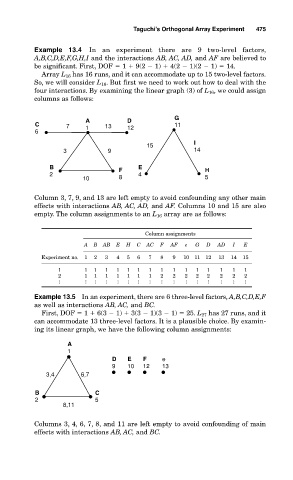Page 516 - Design for Six Sigma a Roadmap for Product Development
P. 516
Taguchi’s Orthogonal Array Experiment 475
Example 13.4 In an experiment there are 9 two-level factors,
A,B,C,D,E,F,G,H,I and the interactions AB, AC, AD, and AF are believed to
be significant. First, DOF 1 9(2 1) 4(2 1)(2 1) 14.
Array L 16 has 16 runs, and it can accommodate up to 15 two-level factors.
So, we will consider L 16 . But first we need to work out how to deal with the
four interactions. By examining the linear graph (3) of L 16 , we could assign
columns as follows:
G
A D
C 7 1 13 12 11
6
I
15
3 9 14
B F E H
2 4
10 8 5
Column 3, 7, 9, and 13 are left empty to avoid confounding any other main
effects with interactions AB, AC, AD, and AF. Columns 10 and 15 are also
empty. The column assignments to an L 16 array are as follows:
Column assignments
A B AB E H C AC F AF e G D AD I E
Experiment no. 1 2 3 4 5 6 7 8 9 10 11 12 13 14 15
1 1 1 1 1 1 1 1 1 1 1 1 1 1 1 1
2 1 1 1 1 1 1 1 2 2 2 2 2 2 2 2
Example 13.5 In an experiment, there are 6 three-level factors, A,B,C,D,E,F
as well as interactions AB, AC, and BC.
First, DOF 1 6(3 1) 3(3 1)(3 1) 25. L 27 has 27 runs, and it
can accommodate 13 three-level factors. It is a plausible choice. By examin-
ing its linear graph, we have the following column assignments:
A
1
D E F e
9 10 12 13
3,4 6,7
B C
2 5
8,11
Columns 3, 4, 6, 7, 8, and 11 are left empty to avoid confounding of main
effects with interactions AB, AC, and BC.

